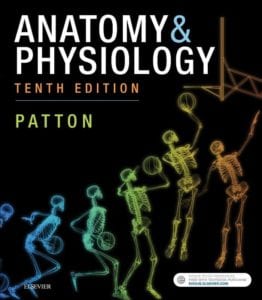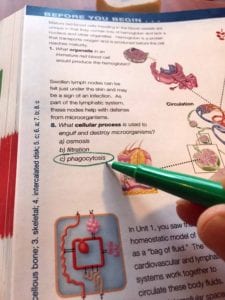 In the hands of an experienced teacher and motivated students, a textbook can be a powerful tool for learning. As with any tool in one’s toolbox, a design that enhances utility, and thereby improves performance, can make a textbook an effective, frequently used implement. As a textbook author, I realize that although effective communication of content is at the center, my textbooks will be used successfully only if the instructional design promotes learning.
In the hands of an experienced teacher and motivated students, a textbook can be a powerful tool for learning. As with any tool in one’s toolbox, a design that enhances utility, and thereby improves performance, can make a textbook an effective, frequently used implement. As a textbook author, I realize that although effective communication of content is at the center, my textbooks will be used successfully only if the instructional design promotes learning.
I’ve been a student of learning science for a long time. Although I’m not close to mastering it, I’ve already found that quite a few applications of the current learning strategies I use in my teaching and in my textbook are working. I want to share with you my most recent application of learning science to textbook design in the hope that it will spark some ideas that are useful for your own projects.
The value of pre-testing
Already familiar with pre-testing as a method to assess prior knowledge, then comparing that to post-testing results to assess any learning that may have occurred, I started running across the notion that pre-testing also improves learning. That is, pre-testing helps a learner practice retrieving knowledge and understanding that they have already mastered, it helps them realize exactly what they have forgotten and need to refresh, and it helps them get a feel for the kinds of things they’ll be expected to do by the end of a learning module. In other words, I kept seeing reports of pre-testing as a learning tool, not simply an assessment tool.
After mulling over all the reasons why it would be too much work for too little reward—for years—I finally made the leap and added pre-testing to all the learning modules in my anatomy and physiology (A&P) courses. It turned out that since I already had an online database of test items and tests, it took very little time to get things up and running. I now had a set of randomized pre-tests that reflected the content of the post-tests, without being duplicates of the post-tests. I was shocked and awed by the results: an average improvement of nearly a whole letter grade on the final exam! Needless to say, I became hooked on the idea.
Collaboration and Development
Last spring I participated in the TAA webinar “Bringing Textbooks to Life: Strategies for Improving Student Engagement” with textbook designer Michael Greer. After the webinar, I rang up Michael and we had a lively discussion of how learning science can inform the design of textbooks. Over the course of several such conversations, Michael helped me adapt what we’d both learned about pre-testing to my textbook, Anatomy & Physiology.
In prior editions, I’d already chunked my content into 48 small chapters, grouped into six themed units. Each chapter unit had a unit-opener page that listed the chapters in that unit and provided a couple of paragraphs briefly introducing the overarching story of the unit. Michael and I agreed that this would be a good spot to try an application of the principle of pre-testing as a learning strategy, and we came up with some rough ideas on what that might include.
Since I was already overwhelmed with the task of revising the nearly 1200 pages of text, I turned for help to my friend and colleague Terry Thompson, an experienced A&P professor who has worked in A&P testing and assessment for some time. She was enthusiastic about the possibilities and, after a bit of collaborative brainstorming, came up with a final plan for executing a new learning feature for our new 10th edition of Anatomy & Physiology (released February 2018). While I was busy with the rest of the book, Terry created six new “Before you begin…” pages to add to our existing unit openers—converting them from a single-page format to a two-page spread.
A New Textbook Feature
 Terry’s new unit openers each present seven or eight test items crafted to review prior learning needed to understand the chapters ahead, as well as preview new learning to be encountered in those chapters. Arranged clockwise around the page, each item includes a brief “set up” that reviews some facts or presents a real-life scenario that involves A&P principles. Each set-up is followed by a question. Each pre-test item also connects to one or more small illustrations from the chapters that immediately spur a visualization of the topics covered in the pre-test. Sometimes these illustrations connect the reader with prior chapters, sometimes they preview an illustration in a later chapter.
Terry’s new unit openers each present seven or eight test items crafted to review prior learning needed to understand the chapters ahead, as well as preview new learning to be encountered in those chapters. Arranged clockwise around the page, each item includes a brief “set up” that reviews some facts or presents a real-life scenario that involves A&P principles. Each set-up is followed by a question. Each pre-test item also connects to one or more small illustrations from the chapters that immediately spur a visualization of the topics covered in the pre-test. Sometimes these illustrations connect the reader with prior chapters, sometimes they preview an illustration in a later chapter.
The answer to each item is available in the margin, printed sideways—just like in a magazine quiz. Readers can guess at each answer, check it in the key along the margin, then move on to the next question. The purpose of the pre-test is to be a low-stakes review/preview—not a summative evaluation of knowledge—so guessing is okay if the answer doesn’t come to mind right away. Having the answers handy also ensures that the students will see the correct answer, making sure they don’t hold on to a mistaken guess. It also “plants the seed” of correct information that will help learning when the topic is encountered in later reading.
Given human nature, it’s not surprising that introducing a new method often produces some hesitance to adopt it —especially one with the emotional baggage that “testing” carries. Anticipating that, I’ve added a boxed hint to each unit opener that briefly explains what the quizzing is supposed to do, and tells the reader not to worry about answering the items correctly.
I realize that not all students will use it, but I’m going to encourage my adopting professors to gently and consistently remind their students of the benefits of this brief “jump start” to learning each unit. Given my experience with pre-testing in the classroom (an average improvement of nearly a whole letter grade!), I have high hopes for this feature’s success. I’ll let you know!
 Kevin Patton is an award-winning professor and textbook author in human anatomy and physiology. A longtime TAA member, he produces a blog at TheTextbookAuthor.orgTo learn more about Kevin’s classroom pre-testing experience visit: my-ap.us/PreTestingAPTo learn more about other instructional design principles Kevin implemented in his textbooks visit: PattonAP.org. Click for the source of this article.
Kevin Patton is an award-winning professor and textbook author in human anatomy and physiology. A longtime TAA member, he produces a blog at TheTextbookAuthor.orgTo learn more about Kevin’s classroom pre-testing experience visit: my-ap.us/PreTestingAPTo learn more about other instructional design principles Kevin implemented in his textbooks visit: PattonAP.org. Click for the source of this article.
No comments:
Post a Comment